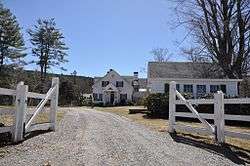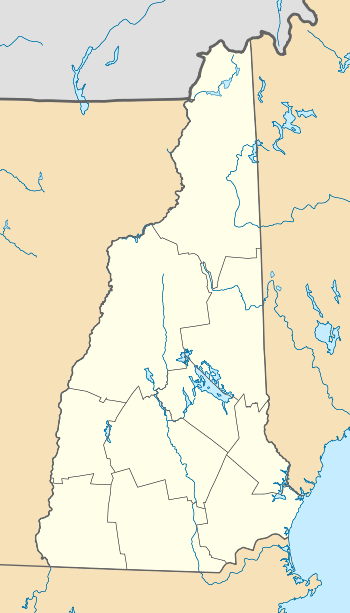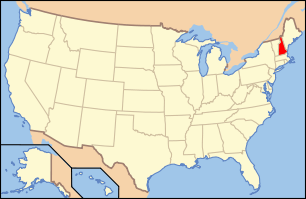Weldwood
Weldwood is a historic summer estate house on Old Troy Road in Dublin, New Hampshire. Built in 1902-03, it is an unusual example of Greek Revival architecture from the early 20th century. The house was listed on the National Register of Historic Places in 1983.[1]
Weldwood | |
 | |
  | |
| Location | Old Troy Rd., Dublin, New Hampshire |
|---|---|
| Coordinates | 42°53′17″N 72°6′25″W |
| Area | 1.4 acres (0.57 ha) |
| Built | 1902 |
| Architectural style | Neo-Greek Revival |
| MPS | Dublin MRA |
| NRHP reference No. | 83004086[1] |
| Added to NRHP | December 15, 1983 |
Description and history
Weldwood is located in a rural setting of southwestern Dublin, on the south side of Old Troy Road about 1 mile (1.6 km) south of Old Marlborough Road. It is a 1-1/2 story wood frame structure, with a gabled roof, two interior brick chimneys, and a clapboarded exterior. Its main facade is five bays wide, with a shed-roof porch extending across it, supported by round columns. Above the porch, three gabled dormers project from the main roof line. A secondary entrance is located on the street-facing north facade, sheltered by a gabled portico and topped by a half-round transom window. The building features corner pilasters and other Greek Revival features, possibly recycled from a farmhouse that previously stood on the property.[2]
This land was settled about 1780 by Amos Emery, who built a farmhouse which stood nearby until 1900, when it was torn down. The present house was built in 1902-03 for George Weld, the brother-in-law of William Amory, who acquired extensive landholdings nearby for his summer estate. Weld operated a summer camp for boys on the property for a few years, and eventually gave it to his son Edric, later headmaster of the Holderness School, as a wedding present.[2]
References
- "National Register Information System". National Register of Historic Places. National Park Service. July 9, 2010.
- "NRHP nomination for Weldwood". National Park Service. Retrieved 2014-05-08.
